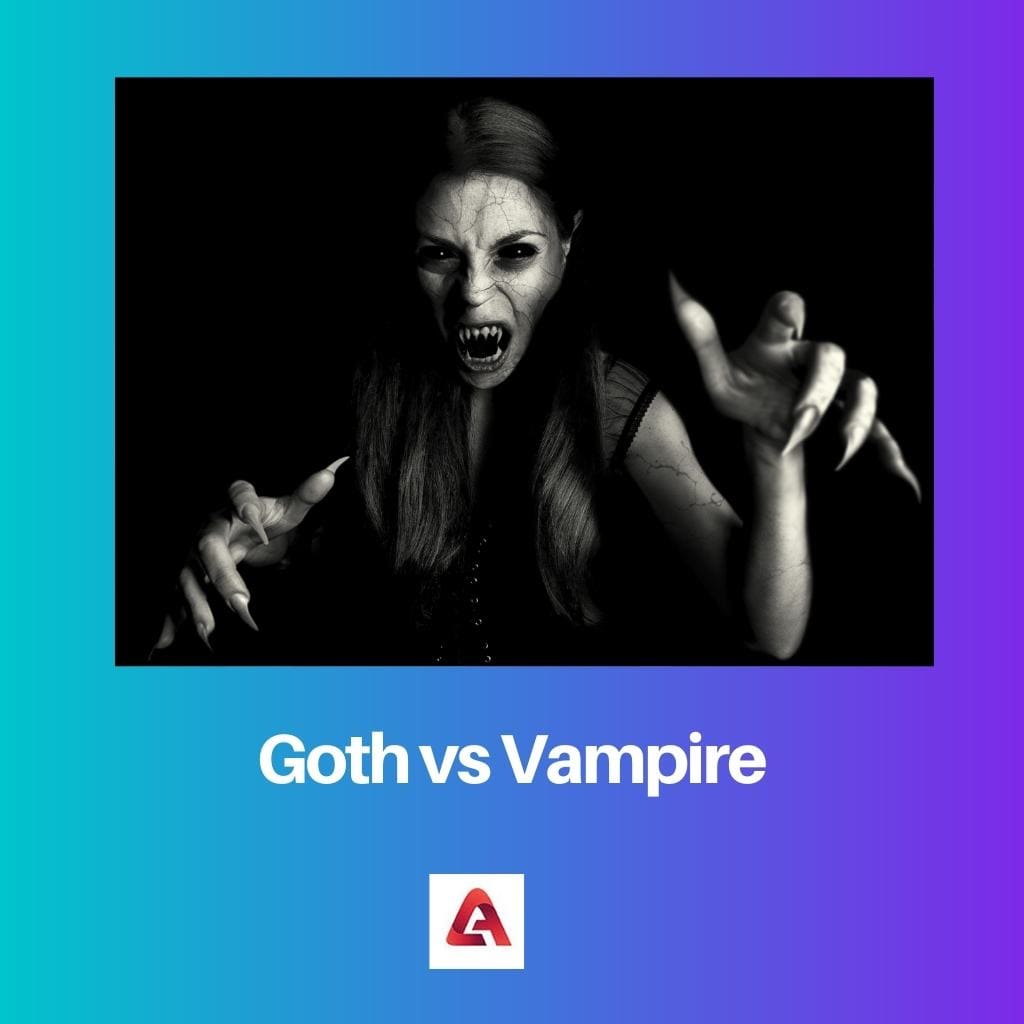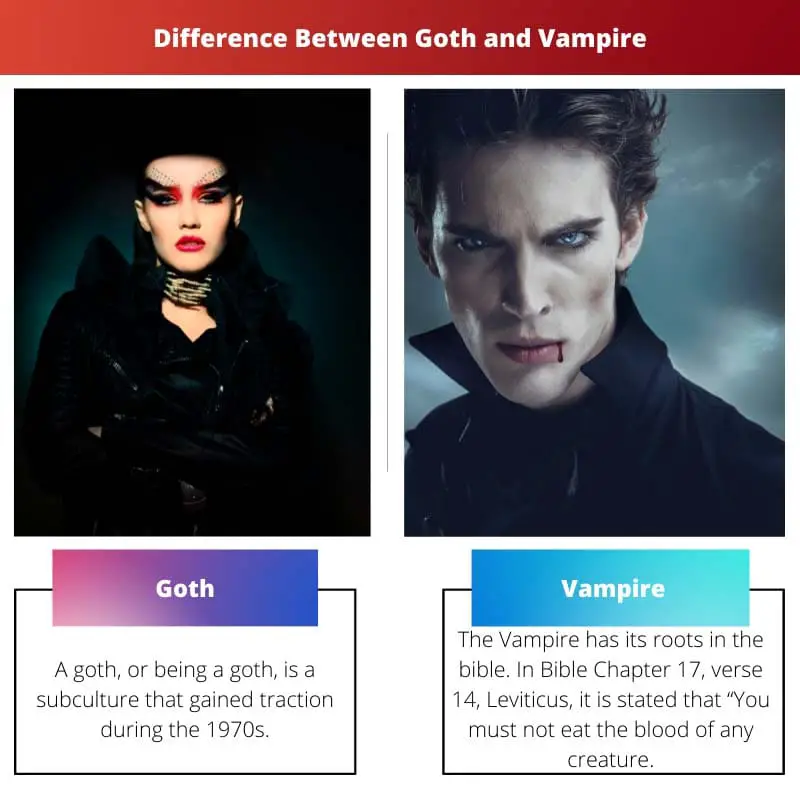Trends drive the world. More bars will open if people like going to bars; if people like browsing social media, further apps will be developed!
Goth and vampire are two of those popular trends. They register well among young adults.
What thoughts come to one’s mind from the words ‘Goth’ or ‘Vampire’? A guy in a black suit, pointed black shoes, wearing chalk-like makeup on his face, speaking like the Hulk?
That might be a vampire and partially a goth too.
Key Takeaways
- Goth is a subculture characterized by a dark and morbid fashion style, while a vampire is a mythical creature that feeds on blood.
- The Goth subculture emerged in the late 1970s and is associated with music genres such as gothic rock and post-punk. At the same time, vampires have been a part of folklore for centuries and are portrayed in literature and movies.
- While Goths are identified by their unique style and music preferences, vampires are known for their supernatural powers, such as immortality and superhuman strength.
Goth vs Vampire
Goth is a subculture that originated in the late 1970s and early 1980s punk scene, emphasising dark and gloomy aesthetics, such as black clothing and gothic architecture. Vampires are mythical creatures that have been part of human folklore for centuries.

Vampires can be seen depicted in popular web series and movies. Real vampires exist, but that is because of a mental condition called ‘haematomania’, an addiction to drinking blood.
Comparison Table
| Parameters of Comparison | Goth | Vampire |
|---|---|---|
| Definition | A person who follows gothic fashion | A creature from folklore, a person who has an obsession with drinking blood |
| Origin date | 1700-1800s | As back as 1735 |
| Mention in literature | Yes | Yes |
| Styling choice | Generally, black clothes | Dark-coloured clothes and wears a cape |
| Medical term associated | None | Haematomania, clinical vampirism, Reinfield’s syndrome |
What is Goth?
A goth, or being a goth, is a subculture that gained traction during the 1970s. The Gothic origins date back to the 18th century.
In the 1960s-1990s, there were heavy metal and punk rock bands like Adam and the Southern Death Cult, Specimen, Sex Gang Children, UK Decay, The Birthday Party, Killing Joke, and the Damned.
Virgin Prunes, the Ants, and the Cure embraced the gothic culture and invented a new music genre called gothic rock.
The current goth subculture is to have been influenced heavily by these music bands.
The fashion of the goth culture is marked by the colour back, dark dresses, an old or antiquated sense of style, and black eyeliner. The goth culture is in love with the colour black.
Goths are seen as dangerous just because they dress differently. The Goth culture is still alive, and the local communities do regular events.
They are considered less harmless, unbothered with other people’s business, and safe to talk to. The goth subculture is not associated with drug usage as in other cultures.
In teens who identify as goths, the rate of self-harm and suicidal tendencies is high.

What is Vampire?
The Vampire has its roots in the bible. In Bible Chapter 17, verse 14, Leviticus, it is stated that “You must not eat the blood of any creature, because the life of every creature is its blood; anyone who eats it must be cut off.”
From there, the concept of vampires arose.
The modern concept of vampires, the one that we all are aware of today, arose from Eastern Europe. There had been reported sightings of vampires.
Eventually, it became a superstition and stayed for hundreds of years. The superstition was that the revenants could come back from the dead and drain the life of the living, and kill them.
Since then, the vampire has become a popular fictional character. The vampire is depicted as evil, romantic, mysterious, a professor of dark desire, and an example of aggression.
Vampires have become popular and are the most popular among young adults. Young females especially have developed a liking for vampires depicted in web series, books, and movies.
Romantic novels involving vampires are popular among you females. Young males have also developed a fan following for vampire-like characters as shown to them in video games, comics, and movies.
The general idea of a vampire is somebody who drinks blood, has sharp teeth, has evil tendencies, and hates sunlight or any light. One might be surprised to know that there exist vampires in real life.
They are normal human beings like you and me. What makes them different is their condition called ‘haematomania’. This is the condition where a person has a constant obsession with drinking blood.
In other terms, this condition is also known as ‘Clinical Vampirism’ or Renfield’s syndrome. Others drink blood as a way of sexual gratification.

Main Differences Between Goth and Vampire
- Goth, or being a goth, is a subculture that came into existence in the 1960-the 80s with an influx of popular people and music bands supporting the movement. On the other hand, vampires surfaced in the 18th century with reported sightings. The superstition rooted the existence of vampires as they are today.
- The goths do not drink other peoples’ or animals’ blood. On the other hand, vampires drink blood, which doesn’t matter whose blood it is.
- Goths do not harm people without reason. On the other hand, if a vampire were to come to life, he would harm people by drinking their blood.
- There is no medical term associated with being goth. On the other hand, if one identifies as a vampire, she might suffer from clinical vampirism or Renfield’s syndrome.
- Goths are not associated with any pre-dated superstitions. On the other hand, vampires are associated with pre-dated superstitions, such as the one that surfaced during the 18th century in Eastern Europe

References
- http://epubs.surrey.ac.uk/732232/
- https://experts.illinois.edu/en/publications/igothi-iundead-subculturei
- https://books.google.co.in/books?hl=en&lr=&id=rZ9clsv_L0EC&oi=fnd&pg=PP1&dq=vampire&ots=h9mPY-fqEg&sig=0eeVl3OmHUHm3CTo5dG__-pc7tE&redir_esc=y#v=onepage&q&f=false

The exploration of real-life haematomania in relation to vampire fascination is an intriguing angle. It adds a layer of complexity to the popular fascination with vampires.
I agree. Understanding the psychological and medical dimensions of vampire fascination provides a nuanced perspective on this cultural phenomenon.
The historical and cultural contexts presented for goth and vampire subcultures offer a deep understanding of their evolution and implications. It’s a thought-provoking analysis of these iconic images.
Absolutely. The interdisciplinary analysis of goth and vampire subcultures provides valuable insights into their enduring influence on popular culture.
I agree. The in-depth exploration of their cultural and psychological underpinnings enriches our perception of these subcultures.
The contrast between the goth subculture and vampire folklore is compelling. It highlights the diverse cultural influences that shape these iconic images.
Absolutely. The interplay of historical, literary, and psychological elements adds depth to our understanding of these subcultures.
Indeed. The convergence of these cultural influences is a testament to the ever-evolving nature of subcultures.
The description of gothic rock and its influence on the goth subculture is enlightening. It provides a comprehensive understanding of its musical roots.
Absolutely. The musical backdrop of the goth subculture is critical to its identity and historical significance.
The comparison table provides a clear understanding of the distinction between Goth and Vampire. It’s intriguing how both have influenced popular media and culture.
Indeed, the cultural impact of both groups is significant. It’s fascinating to see how they’ve been represented in literature and media.
Absolutely. The cultural and historical context of both subcultures is integral to understanding their appeal and perception.
The comparison between goth and vampire provides a comprehensive understanding of their distinct origins and cultural impacts. It’s an illuminating exploration of subcultural dynamics.
Indeed. The holistic exploration of these subcultures contributes to a richer understanding of their enduring appeal and cultural significance.
Absolutely. These comparative insights offer a holistic view of the historical, cultural, and psychological dimensions of the goth and vampire phenomena.
The portrayal of modern vampire appeal is thought-provoking. It’s interesting to consider the psychological and cultural elements driving this fascination.
Absolutely. The psychological and cultural impact on vampire perception is worthy of deeper analysis.
I think the psychological influence on vampire fascination is an intriguing aspect to explore further.
An interesting point on the origin of the vampire myth. The affection for vampires, especially amongst young adults, is fascinating. The roots of the Gothic subculture in music are intriguing.
I agree. It’s fascinating how the idea of vampirism and the Gothic subculture have evolved over time and how they are perceived in the modern world.
The detailed exploration of goth and vampire subcultures offers a comprehensive understanding of their historical, cultural, and psychological dimensions. It’s a fascinating journey through the evolution of these iconic phenomena.
Absolutely. The multidisciplinary analysis of these subcultures enriches our understanding of their timeless allure and significance.
Indeed. The nuanced exploration of goth and vampire phenomena provides valuable insights into their complex historical and cultural influences.
The historical context provided for both Goth and Vampire is insightful. It’s intriguing to see the evolution of these subcultures over time.
I agree. Understanding their origins and historical significance adds depth to the contemporary perception of these subcultures.